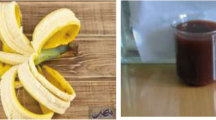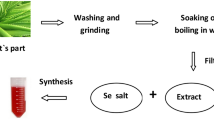Abstract
The current study was aimed for the generation of Pleurotus extracellular extract–mediated selenium and zinc-oxide nanoparticles (NPs). The Pleurotus djamor (PD) and Pleurotus sajor-caju (PSC) extracts were incubated with different concentrations of sodium selenate and zinc acetate to yield BioSeNPs and BioZnONPs. The NPs formation led to visual color change (brick-red and white for Se and Zn nanosols, respectively). The synthesized NPs were spherical with size of 124 and 68 nm and 84 and 91 nm for PD and PSC BioSeNPs and BioZnONPs respectively. The UV absorbance peaks were recorded at 293.2 and 292.2 nm and 365.9 and 325.5 nm for BioSeNPs and BioZnONPs derived from PD and PSC respectively. FT-IR spectroscopy indicated specific functional group adoration on metal-based NPs. On supplementation in straw, these NPs improved the fruit body yield besides enhancing their protein and Se/ Zn contents. These biofortified mushrooms could be potential dietary supplement/ nutraceutical.





Similar content being viewed by others
Data availability
All data supporting the findings of this study are available within the manuscript.
Abbreviations
- BioSeNPs:
-
Biogenic selenium nanoparticles
- BioZnONPs:
-
Biogenic zinc oxide nanoparticles
- BSA:
-
Bovine serum albumin
- FT-IRS:
-
Fourier transform infrared spectroscopy
- NPs:
-
Nanoparticles
- P:
-
Pleurotus djamor
- PSC:
-
Pleurotus sajor-caju
- Se:
-
Selenium
- TEM:
-
Transmission electron microscopy
- Zn:
-
Zinc
References
Abbas H, Abou Baker D (2019) Biological evaluation of selenium nanoparticles biosynthesized by Fusarium semitectum as antimicrobial and anticancer agents. Egypt J Chem 0–0. https://doi.org/10.21608/ejchem.2019.15618.1945
Abdel Wahab D, Othman N, Hamada A (2020) Zinc oxide nanoparticles induce changes in the antioxidant systems and macromolecules in the Solanum nigrum callus. Egypt J Bot 0–0. https://doi.org/10.21608/ejbo.2020.19649.1391
Bhardwaj K, Sharma A, Tejwan N, Bhardwaj S, Bhardwaj P, Nepovimova E, Shami A, Kalia A, Kumar A, Abd-Elsalam KA, Kuča K (2020) Pleurotus macrofungi-assisted nanoparticle synthesis and its potential applications: a review. J Fungi 6:1–21. https://doi.org/10.3390/jof6040351
Bhat R, Sharanabasava VG, Deshpande R, Shetti U, Sanjeev G, Venkataraman A (2013) Photo-bio-synthesis of irregular shaped functionalized gold nanoparticles using edible mushroom Pleurotus florida and its anticancer evaluation. J Photochem Photobiol B Biol 125:63–69. https://doi.org/10.1016/j.jphotobiol.2013.05.002
Brzezicha-Cirocka J, Grembecka M, Grochowska I, Falandysz J, Szefer P (2019) Elemental composition of selected species of mushrooms based on a chemometric evaluation. Ecotoxicol Environ Saf 173:353–365. https://doi.org/10.1016/j.ecoenv.2019.02.036
Castro-Longoria E (2012) Production of platinum nanoparticles and nanoaggregates using Neurospora crassa. J Microbiol Biotechnol 22:1000–1004. https://doi.org/10.4014/jmb.1110.10085
Chang ST, Lau OW, Cho KY (1981) The cultivation and nutritional value of Pleurotus sajor-caju. Eur J Appl Microbiol Biotechnol 12:58–62. https://doi.org/10.1007/BF00508120
Guilger-Casagrande M, de Lima R (2019) Synthesis of silver nanoparticles mediated by fungi: a review. Front Bioeng Biotechnol 7:1–16. https://doi.org/10.3389/fbioe.2019.00287
He L, Liu Y, Mustapha A, Lin M (2011) Antifungal activity of zinc oxide nanoparticles against Botrytis cinerea and Penicillium expansum. Microbiol Res 166:207–215. https://doi.org/10.1016/j.micres.2010.03.003
Kalia A, Kaur G (2018) Biosynthesis of nanoparticles using mushrooms. In: Singh B, Lallawmsanga PA (eds) Biology of macrofungi, Fungal Biology. Springer, Cham, pp 351–360
Kanchi S, Inamuddin, Khan A (2020) Biogenic synthesis of selenium nanoparticles with edible mushroom extract: evaluation of cytotoxicity on prostate cancer cell lines and their antioxidant, and antibacterial activity. Biointerface Res Appl Chem 10:6629–6639. https://doi.org/10.33263/BRIAC106.66296639
Kaur H, Kalia A (2021) Low-cost nano-TiO2 composites for remediation of textile dyes: appraisal on the effect of solar and ultraviolet irradiations. Microsc Res Tech 84:2219–2235. https://doi.org/10.1002/jemt.23775
Kim M-Y, Seguin P, Ahn J-K, Kim J-J, Chun S-C, Kim E-H, Seo S-H, Kang E-Y, Kim S-L, Park Y-J, Ro H-M, Chung I-M (2008) Phenolic compound concentration and antioxidant activities of edible and medicinal mushrooms from Korea. J Agric Food Chem 56:7265–7270. https://doi.org/10.1021/jf8008553
Kora AJ (2020) Nutritional and antioxidant significance of selenium-enriched mushrooms. Bull Natl Res Cent 44:34. https://doi.org/10.1186/s42269-020-00289-w
Lowry OH, Randall RJ (1951) Protein measurement by the folin reagent. J Biol Chem 193:265–275
Manimaran K, Balasubramani G, Ragavendran C, Natarajan D, Murugesan S (2021) Biological applications of synthesized ZnO nanoparticles using Pleurotus djamor against mosquito larvicidal, histopathology, antibacterial, antioxidant and anticancer effect. J Clust Sci 32:1635–1647. https://doi.org/10.1007/s10876-020-01927-z
Mkhize SS, Pooe OJ, Khoza S, Mongalo IN, Khan R, Simelane MBC (2022) Characterization and biological evaluation of zinc oxide nanoparticles synthesized from pleurotus ostreatus mushroom. Appl Sci 12:8563. https://doi.org/10.3390/app12178563
Mleczek M, Siwulski M, Stuper-Szablewska K, Rissmann I, Sobieralski K, Goliński P (2013) Accumulation of elements by edible mushroom species: part I. Problem of trace element toxicity in mushrooms. J Environ Sci Heal Part B 48:69–81. https://doi.org/10.1080/03601234.2012.716733
Mohammed Fayaz A, Girilal M, Rahman M, Venkatesan R, Kalaichelvan PT (2011) Biosynthesis of silver and gold nanoparticles using thermophilic bacterium Geobacillus stearothermophilus. Process Biochem 46:1958–1962. https://doi.org/10.1016/j.procbio.2011.07.003
Moormann G, Bachand G (2021) Biosynthesis of zinc oxide nanoparticles using fungal filtrates. Albuquerque, NM, and Livermore, CA (United States)
Narayanan KB, Sakthivel N (2010) Biological synthesis of metal nanoparticles by microbes. Adv Colloid Interface Sci 156:1–13. https://doi.org/10.1016/j.cis.2010.02.001
Ovais M, Khalil AT, Islam NU, Ahmad I, Ayaz M, Saravanan M, Shinwari ZK, Mukherjee S (2018) Role of plant phytochemicals and microbial enzymes in biosynthesis of metallic nanoparticles. Appl Microbiol Biotechnol 102:6799–6814. https://doi.org/10.1007/s00253-018-9146-7
Patel R (2014) Biogenesis of silver nanoparticles by marine-derived fungus Aspergillus flavus from Bhavnagar Coast, Gulf of Khambhat, India. J Mar Biol Oceanogr 03. https://doi.org/10.4172/2324-8661.1000122
Rana S, Kapoor S, Sharma S, Kalia A (2023) Pleurotus florida mediated biosynthesis of nanoparticles and biofortification. Food Sci Biotechnol. https://doi.org/10.1007/s10068-023-01307-z
Rana S, Sharma S, Kalia A, Kapoor S (2021) Functionalization with bio-molecules derived from oyster mushroom (Pleurotus florida) diminished the antibacterial potential of the mycogenic metal oxide nanoparticles ( NPs ). 30:77–86. https://doi.org/10.36036/MR.30.1.2021.116227
Rastogi L, Arunachalam J (2011) Sunlight based irradiation strategy for rapid green synthesis of highly stable silver nanoparticles using aqueous garlic (Allium sativum) extract and their antibacterial potential. Mater Chem Phys 129:558–563. https://doi.org/10.1016/j.matchemphys.2011.04.068
Serafin Muñoz AH, Kubachka K, Wrobel K, Gutierrez Corona JF, Yathavakilla SKV, Caruso JA, Wrobel K (2006) Se-enriched mycelia of Pleurotus ostreatus: distribution of selenium in cell walls and cell membranes/cytosol. J Agric Food Chem 54:3440–3444. https://doi.org/10.1021/jf052973u
Srivastava S, Bhargava A (2022) Green nanoparticles: the future of nanobiotechnology. Springer, Singapore
Zhao X, Zhou L, Riaz Rajoka MS, Yan L, Jiang C, Shao D, Zhu J, Shi J, Huang Q, Yang H, Jin M (2018) Fungal silver nanoparticles: synthesis, application and challenges. Crit Rev Biotechnol 38:817–835. https://doi.org/10.1080/07388551.2017.1414141
Zhao B, Ding H, Hu T, Guo Y (2023) Synergistic effects of the Se and Zn supplemental combination on the nutrient improvement of mannitol and adenosine and the multi-element bioaccessibility in Cordyceps cicadae. LWT 173:114354. https://doi.org/10.1016/j.lwt.2022.114354
Zięba P, Kała K, Włodarczyk A, Szewczyk A, Kunicki E, Sękara A, Muszyńska B (2020) Selenium and zinc biofortification of Pleurotus eryngii mycelium and fruiting bodies as a tool for controlling their biological activity. Molecules 25:889. https://doi.org/10.3390/molecules25040889
Acknowledgements
The authors are graciously thankful to the Head, Department of Microbiology and Department of Soil Science, Punjab Agricultural University, Ludhiana, 141004, Punjab, India for providing the necessary provisions for the conduct this research. The corresponding author is also thankful to the Director of Research, PAU, Ludhiana for the allocation of funds through the Government of India in Rashtriya Krishi Vikas Yojna (RKVY-18) scheme.
Funding
The funds were obtained from Rashtriya Krishi Vikas Yojna (RKVY-13) scheme, Government of India, New Delhi, India.
Author information
Authors and Affiliations
Contributions
Samson Debbarma performed the experiments and wrote the first draft. Shivani Sharma provided the protocols and obtained inferences from the mushroom cultivation and growth experiment. Anu Kalia provided the protocol and inferences for the synthesis and characterization of the biogenic nanoparticles. Anu Kalia also prepared the figures and reviewed/ edited the manuscript. All authors have given approval to the final version of the manuscript.
Corresponding author
Ethics declarations
Ethics approval statement
Not applicable.
Consent to participate
Not applicable.
Consent for publication
Not applicable.
Competing interests
The authors declare no competing interests.
Additional information
Publisher's Note
Springer Nature remains neutral with regard to jurisdictional claims in published maps and institutional affiliations.
Rights and permissions
Springer Nature or its licensor (e.g. a society or other partner) holds exclusive rights to this article under a publishing agreement with the author(s) or other rightsholder(s); author self-archiving of the accepted manuscript version of this article is solely governed by the terms of such publishing agreement and applicable law.
About this article
Cite this article
Debbarma, S., Sharma, S. & Kalia, A. Pleurotus extract–mediated selenium and zinc nanoparticles exhibited improved yield of biofortified fruit bodies. Int Microbiol (2024). https://doi.org/10.1007/s10123-024-00527-5
Received:
Revised:
Accepted:
Published:
DOI: https://doi.org/10.1007/s10123-024-00527-5




